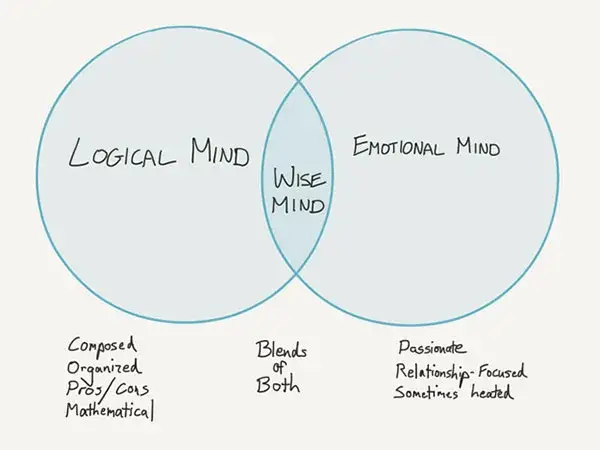PSYCHOTHERAPY
One of the most useful and commonly taught therapies is Dialectical Behavioral Therapy (DBT). This treatment is a sub-form of Cognitive Behavioral Therapy (CBT) in that it emphasizes analyzing thought patterns, building coping skills, and looking at the links between thoughts, emotions, and behaviors. The model of wise mind is sensible and useful for both therapy and mindfulness efforts.
A dialectic is a core principle in DBT. We summarize it as follows:
- Two mutually-exclusive truths that Co-exist
DBT is useful because it focuses on the ‘gray zones’ of life and our minds, and works to move away from polarized or black-or-white thinking. By embracing both sides of a situation (both black and white), a dialect validates your internal conflict. The wise mind structure allows for a person to hold both logical parts and emotional parts concurrently. The Venn diagram illustrating wise mind is as follows:
There are legitimate and healthy times for a person to exist in each of the above mind states. One of the goals of learning about this blend is to have greater insight as to the right state at the right time. For instance, you would be more useful in a logical mind state when changing a flat tire on the highway, but many people are so upset that they will be entirely in an emotional mind state. Your flat tire doesn’t care! Our goal in this instance is to line you up with the best mind state for your current purposes.
The opposite would also be true. Being entirely mathematical and logical on a date may come across as flat or boring. To build a greater bond, you’re going to need to embrace a wise mind or emotional mind state, as these positions build a greater emotional connection with others.
A pop-culture example of wise mind states would be using some fictional characters. The most defined ‘logical mind’ character would be Spock from the Star Trek series. The best ’emotional mind’ example would be Miss Piggy from The Muppets. Each represents a polarized extreme of the mind states.
Efforts to Change Your State of Mind
We first seek to understand the mind structure and be aware of what state you are in at a given time. Next, we look at whether or not this state serves you well. For instance, if you have to go to a court hearing and are entirely in an emotional mind state, the judge will probably look down on you for being erratic and unstable. There are some skills you can put into play here to help you move a little bit to the left, into wise mind.
Examples would include:
- Seek validation from a friend
- Use a mindfulness skill such as distraction or mindful breathing to calm your nerves
- Use a logical skill such as listing the Pros versus the Cons
So to summarize wise mind:
- You naturally have different mind states
- There tends to be a ‘best’ state for a given situation, but not necessarily
Mindfulness and awareness can help you move your mind state to whatever you need
Read more CeDAR Education Articles about Psychotherapy including Partitioning Trust.

